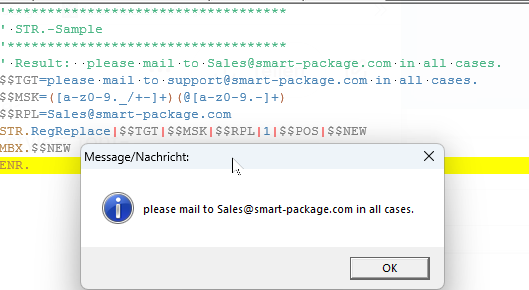MiniRobotLanguage (MRL)
STR.RegReplace
Replace Text in a String Using Regular Expressions

Intention
This command scans a target string for a matching regular expression and replaces it with a specified string.
The result is either placed on the Top of Stack (TOS) or in optional variables.
The command uses regular expressions for matching. It supports a variety of metacharacters and special sequences.
If no match is found, the position variable will be set to zero, and the new target string will be a direct copy of the original.
The search is case-insensitive by default.
Syntax
STR.RegReplace|P1|P2|P3[|P4|P5|P6]
Parameter Explanation
•P1 - (Target String) The string in which to search and replace.
•P2 - (Regular Expression Mask) The regular expression to match.
•P3 - (Replacement String) The string to replace the matched text with.
•P4 - (Optional) Starting position in the target string.
•P5 - (Optional) Variable for the new position. If omitted, the result is placed on TOS.
•P6 - (Optional) Variable for the new target string. If omitted, the result is placed in P1.
Metacharacters Table for STR.RegRepl
Char |
Definition |
. |
(period) Matches any character, except the end-of-line. |
^ |
(caret) Matches the actual beginning-of-line position or the preceding line-delimiter character pair (CHR$(13,10) or $CRLF). |
$ |
(dollar) Matches the end-of-line position or the first line-delimiter character pair (CHR$(13,10) or $CRLF) that is encountered. |
` |
` |
? |
(question mark) Specifies that zero or one match of the preceding sub-pattern is allowed. |
+ |
(plus) Specifies that one or more matches of the preceding sub-pattern are allowed. |
* |
(asterisk) Specifies that zero or more matches of the preceding sub-pattern are allowed. |
[ ] |
(square brackets) Identifies a user-defined class of characters. |
[-] |
(hyphen) Identifies a range of characters to match. |
[^] |
(caret) Identifies a complemented class of characters, which will not match. |
Character Classes Table for STR.RegRepl
Symbol |
Definition |
[ ] |
Square brackets identify a user-defined class of characters, any of which will match. For example, [abc] will match a, b, or c. |
\\, \-, \], \e, \t, \v, \x## |
These are the only special metacharacters recognized within a class definition. Any other use of a backslash yields an undefined operation. |
[-] |
The hyphen identifies a range of characters to match. For example, [a-f] will match a, b, c, d, e, or f. |
|
Characters in an individual range must occur in the natural order. For example, [f-a] will match nothing. |
|
Multiple ranges in a class are valid. For example, [a-d2-5] matches a, b, c, d, 2, 3, 4, or 5. |
|
When the hyphen is escaped, it is treated as a literal. For example, [a\-c] matches a, -, or c. |
[^] |
When the caret appears as the first item in a class definition, it identifies a complemented class of characters, which will not match. For example, [^abc] matches any character except a, b, or c. |
|
A range can also be specified for the complemented class. For example, [^a-z] matches any character except a through z. |
Tags/Sub-patterns Table for STR.RegRepl
Symbol |
Definition |
( ) |
Parentheses are used to match a Tag, or sub-pattern, within the full search pattern. The matched sub-pattern can be retrieved later in the mask or in a replace operation with \01 through \99. |
|
Parentheses can also be used to force precedence of evaluation with the alternation operator ` |
|
Note: Parentheses may not be used with ?, +, * as any match repetition could cause the tag value to be ambiguous. To match repeated expressions, use parentheses followed by \01*. |
Escaped Characters Table for STR.RegRepl
Escape Sequence |
Definition |
\\ |
Backslash, treated as a literal value. |
\b |
A word boundary. Matches the start or end of a word. |
\c |
Enables case-sensitive search. |
\e |
Escape character: CHR(27) or "ESC". |
\f |
Formfeed character: CHR(12) or "FF". |
\n |
Linefeed (or newline) character: CHR(10) or "LF". |
\q |
Double-quote mark ("): CHR(34) or "DQ". |
\r |
Carriage-return character: CHR(13) or "CR". |
\s |
Shortest match character. |
\t |
Horizontal tab character: CHR(9) or "TAB". |
\v |
Vertical tab character: CHR(11) or "VT". |
\x## |
Hex character code. |
\## |
Tag number. Evaluated as the characters matched by tag number ##. |
Restrictions
•To maximize performance, avoid overuse of the *, +, and ? metacharacters.
Example
'***********************************
' STR.-Sample
'***********************************
' Result: please mail to Sales@smart-package.com in all cases.
$$TGT=please mail to support@smart-package.com in all cases.
$$MSK=([a-z0-9._/+-]+)(@[a-z0-9.-]+)
$$RPL=Sales@smart-package.com
STR.RegReplace|$$TGT|$$MSK|$$RPL|1|$$POS|$$NEW
DBP.$$NEW
ENR.
Remarks
-
Limitations:
-
See also:
•